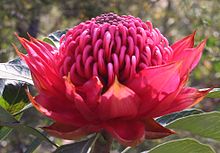Telopea speciosissima
| Telopea speciosissima | |
|---|---|
 |
|
| Telopea speciosissima flowerhead with florets opening from the edges towards the centre, Blue Mountains, Australia | |
| Scientific classification | |
| Kingdom: | Plantae |
| (unranked): | Angiosperms |
| (unranked): | Eudicots |
| Order: | Proteales |
| Family: | Proteaceae |
| Genus: | Telopea |
| Species: | T. speciosissima |
| Binomial name | |
|
Telopea speciosissima (Sm.) R.Br. |
|
| Synonyms | |
|
|
Telopea speciosissima, commonly known as the New South Wales waratah or simply waratah, is a large shrub in the plant family Proteaceae. It is endemic to New South Wales in Australia and is the floral emblem of that state. No subspecies are recognised, but the closely related Telopea aspera was only recently classified as a separate species.
T. speciosissima is a shrub to 3 or 4 m (9.8 or 13.1 ft) high and 2 m (6.6 ft) wide, with dark green leaves. Its several stems arise from a pronounced woody base known as a lignotuber. The species is well renowned for its striking large red springtime inflorescences (flowerheads), each including hundreds of individual flowers. These are visited by the eastern pygmy possum (Cercartetus nanus), birds such as honeyeaters (Meliphagidae), and various insects.
The floral emblem for its home state of New South Wales, Telopea speciosissima has featured prominently in art, architecture, and advertising, particularly since Australian federation. Commercially grown in several countries as a cut flower, it is also cultivated in home gardens, requiring good drainage yet adequate moisture, but is vulnerable to various fungal diseases and pests. A number of cultivars with various shades of red, pink and even white flowers are available. Horticulturists have also developed hybrids with T. oreades and T. mongaensis which are more tolerant of cold, shade, and heavier soils.
Telopea speciosissima, the New South Wales waratah, is a large, erect shrub up to 3 or 4 metres (9.8 or 13.1 ft) in height with one or more stems. Arising vertically or near vertically from a large woody base, or lignotuber, the stems are little branched. In late spring, there is a spurt of new growth after flowering, with new shoots often arising from old flowerheads. The dark green leaves are alternate and usually coarsely-toothed, ranging from 13 to 25 cm (5 to 10 in) in length. Enveloped in leafy bracts, the flowerheads develop over the winter and begin to swell in early spring, before opening to reveal the striking inflorescences. The exact timing varies across New South Wales, but flowering can begin as early as August in the northern parts of its range, and finish in November in the southern, more elevated areas. Spot flowering may also occur around March in autumn. Containing up to 250 individual flowers, the domed flowerheads are crimson in colour and measure 7–10 cm (3–4 in) in diameter. They are cupped in a whorl of leafy bracts which are 5 to 7 cm (2 to 3 in) long and also red. Variations are not uncommon; some flowerheads may be more globular or cone-shaped than dome-shaped, and the bracts may be whitish or dark red. The tips of the stigmas of some inflorescences may be whitish, contrasting with the red colour of the rest of the flowerhead.
...
Wikipedia
